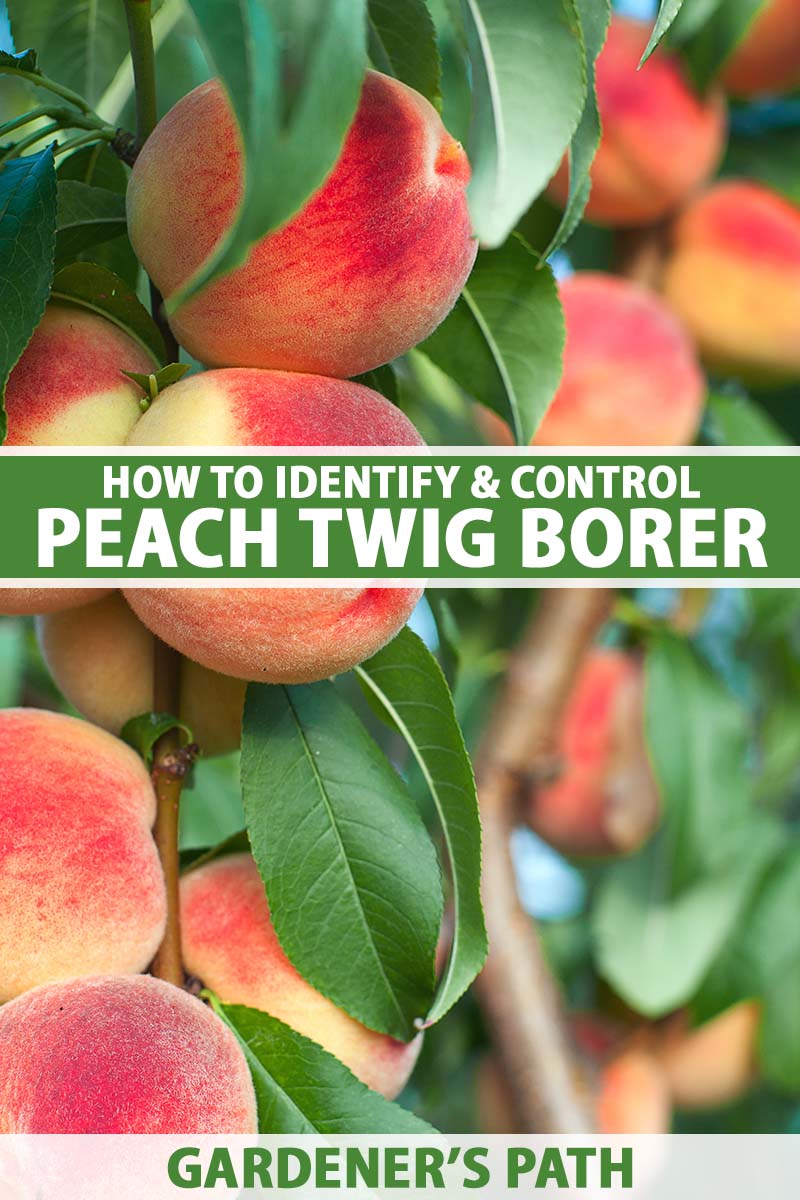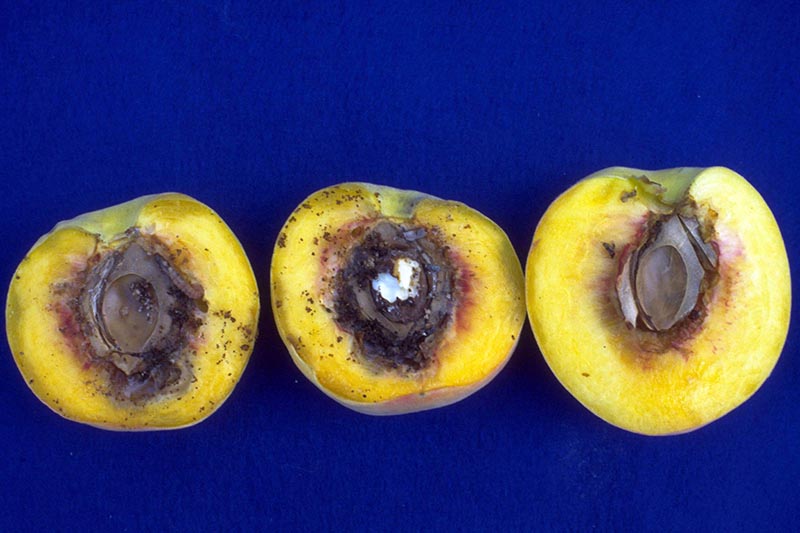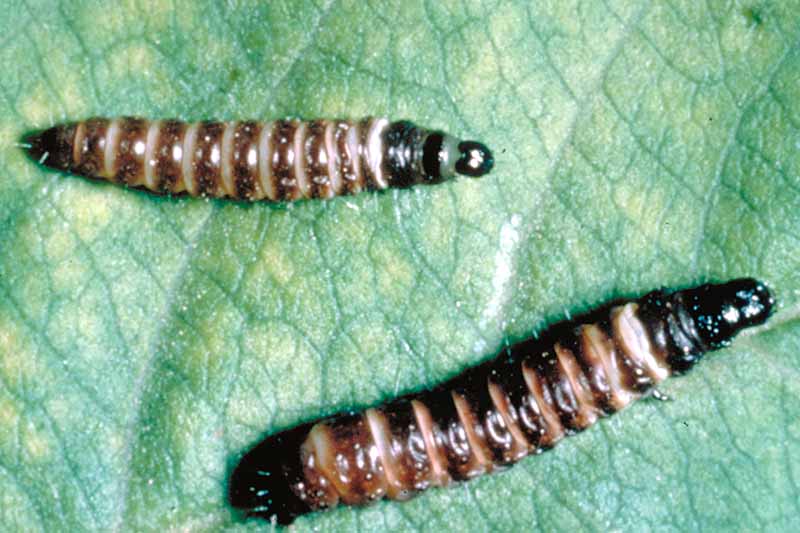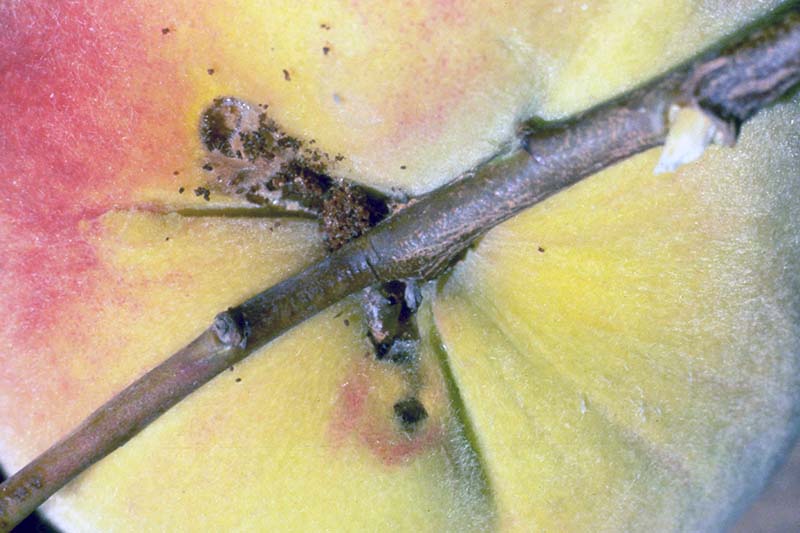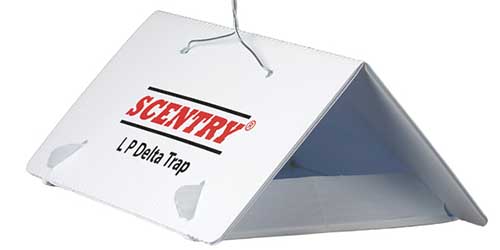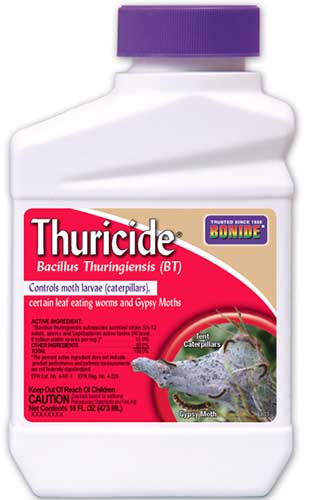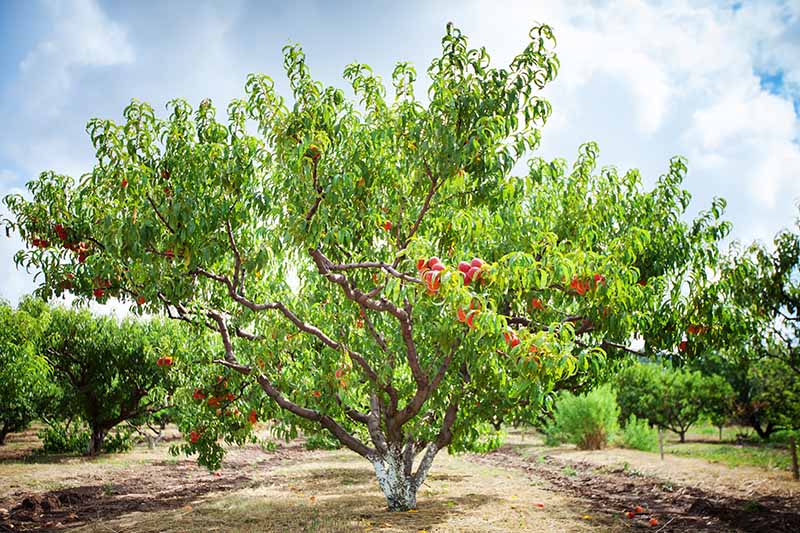This pest originates in Europe and was first identified in the US in California in the 1880s. It attacks a variety of stone fruits, including peaches, apricots, plums, prunes, and nectarines. And as its name suggests, it’s a particularly serious pest of peaches. We link to vendors to help you find relevant products. If you buy from one of our links, we may earn a commission. Here’s what’s ahead:
What Are Peach Twig Borers?
Peach twig borers are voracious pests. They cause various types of damage that can be particularly severe on young trees. In the spring and early summer, the larvae damage new buds and shoots, and the later generations feed primarily on the developing fruit. Young trees are the most susceptible to damage from feeding on new shoots because it kills the terminal growth, and lateral branches can develop. This will damage the ability of the tree to bear fruit that season. You’ll find that your trees start to look wilted and their growth may be stunted. The maturing – and mature – fruit are also susceptible to attack. The larvae feed under the skin of the fruit, which are most likely to sustain damage from the period when color break begins, a gradual changing from green to the fruit’s mature color, through to harvest. They can hollow out areas inside the fruit and may leave exit holes. The second-generation larvae become active in early summer and can cause severe damage to fruit that ripen in late July and August. The second and third generations overlap in late July and early August, so the fruit are frequently infested with larvae from both of these generations. In warmer climates, the moths may produce a fourth generation and possibly even a fifth one, whose larvae travel down the limbs, eating and causing damage, before hibernating over the winter months.
Identification
Identification of this pest can be tricky, since the damage it causes often looks like that of the oriental fruit moth (Grapholia molesta). You can identify the peach twig borer larvae by their black heads and chocolate brown color, with alternating light and dark bands around the abdomen. They are about half an inch long when mature. Other types of larvae found in stone fruits do not look like this. For example, the larvae of the oriental fruit moth are white or pink, with brown heads. The peach twig borer is common in the Mediterranean and is also found throughout other parts of Europe, Asia, and North America. To date, it is not found in Japan or Oceania. The adult moths are gray with mottled wings, measure a third of an inch to half an inch long, and have prominent palpi (modified mouthparts) that give the appearance of a snout.
Biology and Life Cycle
Peach twig borers can produce three to five generations a year, depending on the climate. In colder climates such as that of Washington, these insects usually produce three generations. However, in warmer climates such as what you’ll find in Texas, they may have four or five. After mating, the moths lay masses of about 80-90 yellowish or orange eggs on the leaves and twigs of trees, or the surface of fruit. The eggs will hatch in about five to eight days if the temperatures are favorable, or up to 18 days if it is cool. When the larvae hatch, they will feed on shoots, fruit, and buds. When they’ve had their fill, they will pupate. The larvae do not pupate in a cocoon. Instead, they choose protected places on trees or burrow into the stem cavity of fruit. Pupae mature in as little as seven to 11 days during the warm summer months, but may take up to 30 days for those pupating in spring, in cooler temperatures. The adults then emerge, mate, and the cycle starts again. What about winter? The larvae can overwinter within tiny silken cells (called hibernacula) that can be deep in cracks in the bark, in pruning wounds, or the crotches of twigs and branches. You can identify these sites by the piles of red frass that extend upward from them. That’s insect poop, in case you were wondering. The overwintered larvae emerge in early spring when the temperatures reach about 60°F, and travel up the limbs to feast on the newly emerged leaves, shoots, and buds. They may also feed on the bark before the trees go into the pink bud stage. This is the stage known as “pre-bloom,” when the flower buds just start to open and expose the petals. As the growth on the end of the limbs develops, the larvae will bore down the center of a single shoot, causing the terminal to wilt. The dead shoots caused by this feeding are known as shoot strikes. These larvae then settle down to pupate and emerge as adults during a two-week period in the late spring. The next group of larvae develop soon after, and these will produce moths in the early summer. These moths lay eggs and generate more larvae.
Monitoring
During the growing season, care should be taken to apply sprays as the larvae are hatching, before they bore into shoots or fruits. Commercial growers use a method called degree-day monitoring to time insecticide applications, but this is beyond the scope of this article. You will need to monitor the emergence of the larvae and the moths, so you can apply treatments when they will be the most effective. So how do you know when the larvae are emerging? You can check your trees carefully early in the season for signs of emergence and also use pheromone traps to monitor the adult populations. Treatment early in the season will help to reduce the severity of summer infestations. Insecticide applications during the summer months are very difficult to time correctly without the use of degree-day monitoring, as they need to be applied while the larvae are actively feeding.
Monitor the Hibernacula
As the tree comes out of dormancy, a period called “delayed dormancy” refers to the time between bud swell and the emergence of green shoots. This is typically the time when the overwintering larvae start to emerge from their hibernacula. Check your trees carefully for the presence of hibernacula, which can be identified by the red frass.
Monitor Shoot Strikes
Wilted shoots are easy to spot, and you should monitor trees of all ages for shoot strikes in spring. They’re easiest to see on young trees.
Use a Pheromone Trap to Monitor the Adults
The use of pheromone traps to monitor the adult population will help you confirm that the pests in your orchard are peach twig borers and not some other type of insect. Damage can be hard to spot in taller, more established trees, so by keeping an eye on adults, you can take action accordingly. Check for the presence of eggs, which typically hatch in five to 11 days depending on the temperature, and time your treatment accordingly. Scentry Plastic Delta Trap Scentry Delta Traps are available from Arbico Organics. You will need to purchase the lure separately, also from Arbico Organics. Check the traps twice a week. You will need to replace the trap bottoms if dust or debris has accumulated. As soon as you see more than a couple of moths per trap, you will know that you need to monitor more closely. If you have found adults, be sure to apply a spray during the dormant period, as discussed below, to prevent infestation during the next growing season.
Control Methods
Knowing when to treat this pest can be complicated. For best results, treatments during dormancy and early in the season can prevent the later generations from destroying your harvest. Cultural controls can include cutting out and removing the hibernacula during dormancy, and pruning the damaged shoot strikes early in the season to remove the larvae. Commercial growers may use a variety of different insecticides to control peach twig borer, but for the home grower, spinosad and Bacillus thuringiensis kurstaki are more environmentally sound options. Pyrethrins can also be effective but they typically provide just five to seven days of protection, so will require careful timing to ensure that application coincides with the emergence of larvae.
Treatment During Bloom
If you use insecticides while trees are in bloom, you could inadvertently damage local bee populations – even if the insecticide is labeled as safe to use during the bloom period. Many insecticides that are effective against peach twig borers will also kill the beneficial insects that control mites and the San Jose scale. This means rebound infestations of these organisms may occur during the summer. Spinosad is an effective insecticide to use during the dormant and delayed dormancy period that will not damage beneficial insects, but will kill the overwintering PTB larvae. Monterey Garden Insect Spray It’s available as Monterey Garden Insect Spray from Arbico Organics. Since overwintering mites and scale insects could be a problem later in the year, you can add dormant oil to your spinosad applications. Dormant oils are typically made from mineral oil, with or without added insecticide, and they work by smothering the overwintering eggs of insect pests. It’s important to note that the oil alone will not help to control peach twig borer. Another option is Bacillus thuringiensis kurstaki. Btk is a highly effective microbial and organic insecticide that may be used to target the newly emerging larvae. Bonide Thuricide You can find Btk available as Bonide Thuricide, from Arbico Organics. Plan to apply Btk during the delayed dormancy stage to target the larvae as they emerge. Reapply seven to 10 days later. Btk is only effective if you treat the larvae before they tunnel into the twigs or fruit. If you see several shoot strikes per tree by late April, you can make another application of Btk, or apply spinosad if you didn’t use Btk during delayed dormancy. You should avoid organophosphate insecticides. Although effective, they readily contaminate water sources. Bees can pick up insecticide residues in the pollen and take it back to their hives. There, it is fed to the bee larvae. The effects of such insecticides are not clear, but it is wise to err on the side of caution when there are other options available. Once again, Btk is a good option to kill the peach twig borer larvae without damaging the bees. Ideally, two applications of Btk should be used: the first when 10 to 20 percent of the flowers are blooming, and the second at full bloom, but before petal fall. Spinosad and pyrethrins are also effective at this stage, but they are toxic to bees. For best results, you will need to treat your trees in the dormant stage, and when the larvae first emerge in springtime. Treatment for later generations is more difficult to time accurately, so early detection via monitoring is crucial. Have you had to fight an infestation of peach twig borers? If so, let us know how your trees fared in the comments section below. And for more information on garden pests, check out these guides next:
How to Diagnose and Prevent Phony Peach DiseaseHow to Identify and Control Root MaggotsHow to Eradicate Tent Caterpillars (and Whether You Should)
